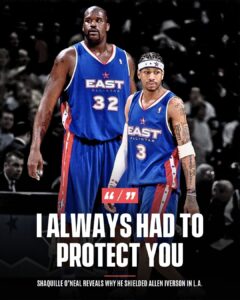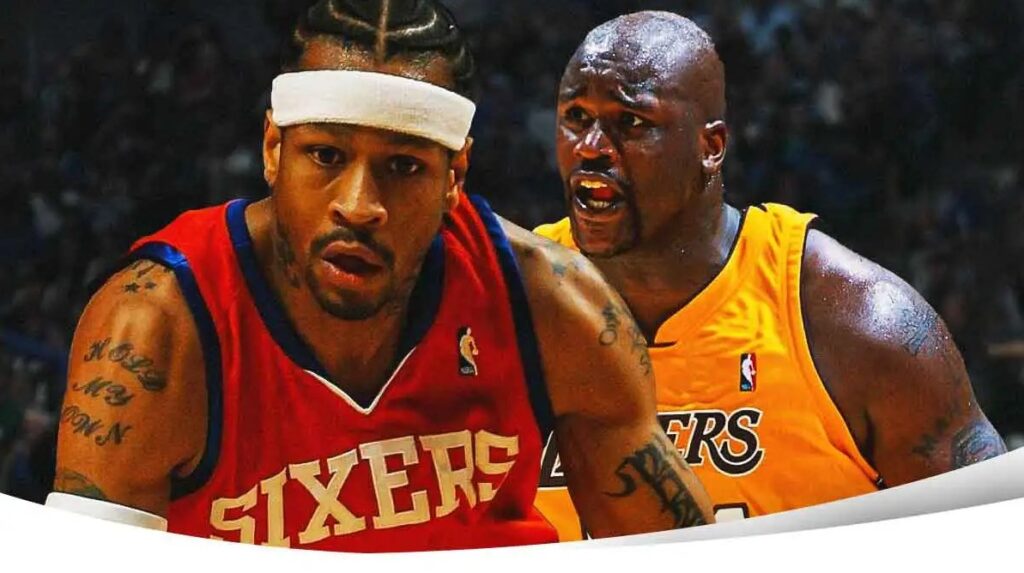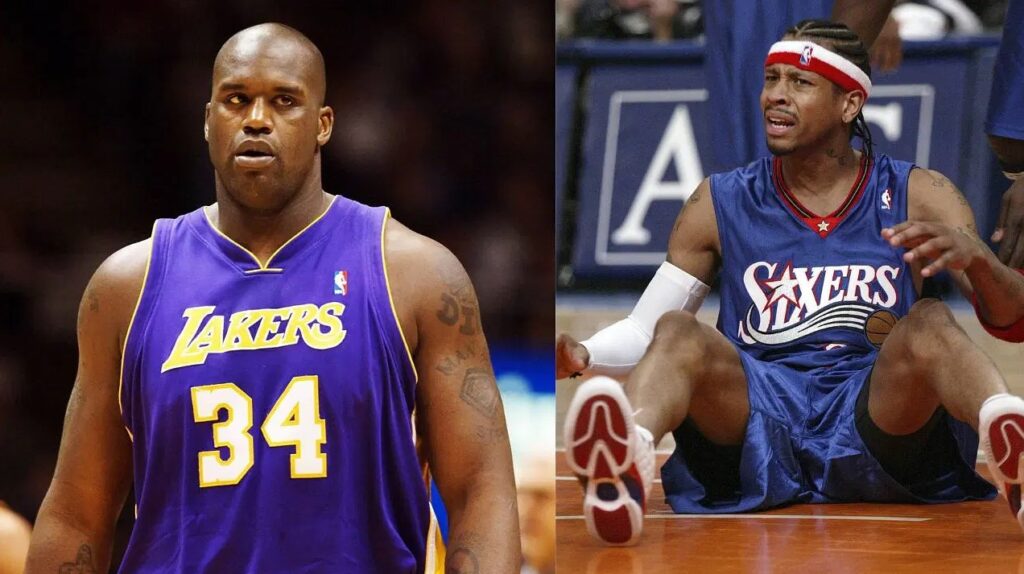Shaq and Allen Iverson: The Brotherhood That Transcended Basketball Rivalry
In a shocking revelation that has sent ripples through the basketball community, NBA legend Shaquille O’Neal recently opened up about the extraordinary lengths he went to protect fellow superstar Allen Iverson during their playing days, including the surprising act of hiding Iverson’s signature chain whenever they were in Los Angeles to shield him from potential trouble with local gangs and street elements. This unprecedented disclosure, made during a candid podcast appearance, has illuminated a side of professional basketball that fans rarely get to witness – the genuine brotherhood that can develop between competitors who, on the surface, appeared to be nothing more than fierce rivals battling for supremacy on the hardwood.

The revelation about the hidden chain represents far more than a simple gesture of friendship; it symbolizes the profound responsibility that established veterans like Shaquille O’Neal felt toward their younger counterparts, particularly those who, like Allen Iverson, carried themselves with a street credibility and cultural authenticity that could potentially attract unwanted attention from dangerous elements in major metropolitan areas like Los Angeles. When O’Neal made the conscious decision to conceal Iverson’s jewelry, he was essentially acting as a protective older brother, understanding that the flashy accessories that were part of Iverson’s identity and brand could make him a target for robbery, violence, or worse in certain neighborhoods where such displays of wealth were viewed as provocative challenges rather than expressions of success.
The podcast conversation between these two basketball icons revealed layers of mutual respect and admiration that extended far beyond their on-court performances, with O’Neal admitting that he would occasionally allow Iverson to score points during their matchups as a sign of recognition for his talent and as a gesture of respect for what the Philadelphia 76ers guard represented to the culture of basketball and urban America. This admission challenges the conventional narrative of professional sports, where every possession, every point, and every advantage is supposedly contested with maximum intensity, revealing instead a more nuanced understanding of competition where seasoned veterans could recognize and honor exceptional talent even when it belonged to an opponent.

Perhaps even more touching was Iverson’s embrace of the nickname “Baby Shaq,” a moniker that might have been considered insulting or diminutive by other players but was instead worn as a badge of honor by the Answer, demonstrating his genuine appreciation for O’Neal’s mentorship and the validation that came with being associated with one of the most dominant centers in basketball history. The fact that Iverson not only accepted but celebrated this nickname speaks volumes about the depth of trust and affection that had developed between these two superstars, transcending the typical boundaries of team loyalties and conference rivalries that usually define relationships between players of their caliber.
Their bond, as revealed through this intimate conversation, represents something far more significant than the typical professional relationships that exist between athletes who happen to play the same sport; instead, it embodies the kind of authentic connection that is built on shared experiences, mutual understanding of the unique pressures that come with superstardom, and a genuine concern for each other’s well-being that extends far beyond the basketball court and into the realm of personal safety and emotional support.
The stories shared during their podcast appearance paint a picture of two men who recognized in each other not just exceptional basketball talent, but kindred spirits who understood the complexities of being larger-than-life figures in American sports culture, dealing with the constant scrutiny, the pressure to perform, and the sometimes dangerous attention that comes with fame and success in a society where athletes are often viewed as symbols rather than human beings with real vulnerabilities and concerns.

This revelation about their relationship serves as a powerful reminder that behind the highlight reels, the statistics, and the championship pursuits, professional athletes are human beings who form genuine connections with their peers, looking out for one another in ways that the public rarely sees or understands, creating bonds of loyalty and brotherhood that can last a lifetime and influence decisions both on and off the court in ways that transcend the competitive nature of professional sports.
The legacy of Shaq and Allen Iverson’s friendship extends beyond their individual accomplishments and accolades, representing instead a model of how athletes can support and protect one another while still maintaining their competitive edge, proving that true champions understand that their greatest victories sometimes come not from defeating their opponents, but from lifting them up and ensuring their safety and success in a world that can be as dangerous as it is rewarding.